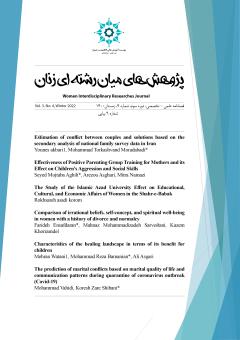-
-
List of Articles
-
Open Access Article
1 - Estimation of conflict between couples and solutions based on the secondary analysis of national family survey data in Iran
Akbari younes Mohammad Torkashvand -
Open Access Article
2 - Effectiveness of Positive Parenting Group Training for Mothers and its Effect on Children's Aggression and Social Skills
mojtaba aghili Arezou Asghari mitra namazi -
Open Access Article
3 - The Study of the effect of Islamic Azad University in Educational, Cultural and Economic Affairs of Women in the Shahr-e-babak
Rokhsareh asadi korom -
Open Access Article
4 - Comparison of Irrational Beliefs, Self-concept, and Spiritual Well-being in Women with a History of Divorce and Normalcy
فریده انصافداران mahnaz mohammadi zadeh kazem khorramdel -
Open Access Article
5 - Characteristics of the healing landscape in terms of its benefit for children
Mehran Vatani MohammadReza Bemanian Ali Asgari -
Open Access Article
6 - The prediction of marital conflicts based on marital quality of life and communication patterns during quarantine of coronavirus outbreak (Covid-19)
Mohammad Vahidi Kooresh Zare Shibani
-
The rights to this website are owned by the Raimag Press Management System.
Copyright © 2017-2025







